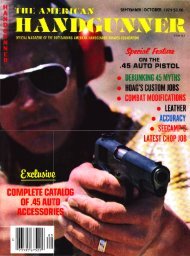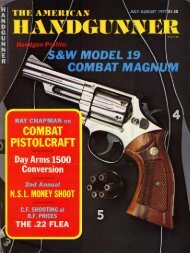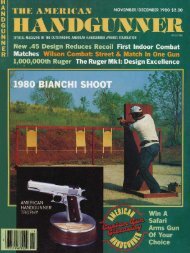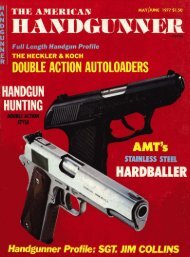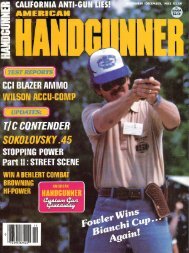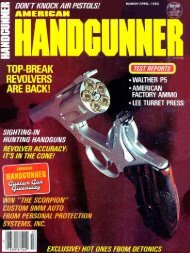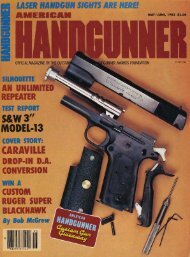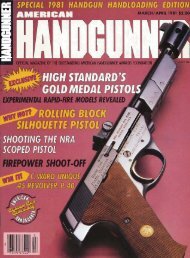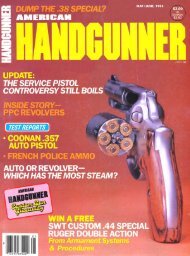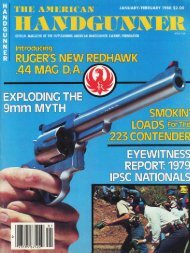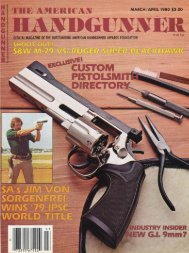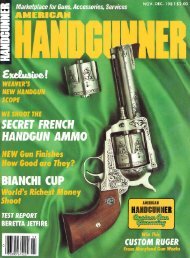American Handgunner July/August 1982
American Handgunner July/August 1982
American Handgunner July/August 1982
Create successful ePaper yourself
Turn your PDF publications into a flip-book with our unique Google optimized e-Paper software.
pull, though, was excellent-an ounce over<br />
three pounds, with the barest perceptible<br />
trigger movement after sear release.<br />
In the interest of fairness, it must be<br />
stated that no new gun will ever be as<br />
smooth as one that has been cycled a few<br />
thousand times. A characteristic of S&W<br />
actions is that they get smoother with use,<br />
and mine are well used. Most certainly,<br />
they're more civilized now than when they<br />
were new.<br />
Since the L frame is visibly smaller than<br />
the N, I was surprised at how heavy it felt.<br />
A consultation with Mr. Fairbanks-MoJ:se<br />
quickly revealed that, at 46 ounces, the 6<br />
inch L is 2 ounces heavier than my 5-inch<br />
N model, and weighs 9 ounces more than<br />
ger is smooth and wider than the regular<br />
S&W trigger, but not as wide as the extra<br />
cost target or combat models. It is also<br />
thick and chunky looking, as if they took a<br />
wide trigger blank and just tapped it with<br />
the forging hammer so it didn't get mashed<br />
as much as it should have been. The trigger<br />
works fine, it just doesn't have the classic<br />
S&W look.<br />
The hammer's unusual appearance<br />
stems·from the fact that the cocking spur is<br />
placed low. This makes the nose proportionately<br />
longer than on K or N. But the<br />
low spur is there for a reason. L's grip<br />
frame is exactly the same as K's. This exactness<br />
is carried to the location of the<br />
hammer spur and even the thumb latch,<br />
ing. This gives a due as to what the Smith<br />
& Wesson folks had in mind for the new<br />
frame size. More on this subject later.<br />
The final departure from previous practice<br />
was noted in the serial numbering system.<br />
The test gun's number is AAB0024. A<br />
call to S& W gave me the key to the new<br />
procedure. The first L frame gun produced<br />
was No. AAAOOOI. Gun No. 10,000 was<br />
AABOOOO. Thus, the test gun was the<br />
1O,024th L frame gun built.<br />
While taking the gun apart for detailed<br />
comparison photos, I gently touched a few<br />
spots on the L's action parts with a hard<br />
Arkansas stone to hurry the aging process.<br />
After the photo session, when the L was reassembled,<br />
its DA mechanism was better.<br />
-<br />
These S&W cylinders fit, from left to right, Models K, L, N.<br />
Triggers I hands: ~ (longest), L, K (shortest).<br />
Hammers, Models N,L,K (left to right), are slightly diHerent.<br />
L barrel' has nearly tVl(ice metal thickness' at throat.<br />
AMERICAN HANDGUNNER· JULY IAUGUST <strong>1982</strong><br />
the 4-inch 19, which tips the scales at a<br />
mere 37. The extra weight, of course, is in<br />
'the barrel, which gives the gun a distinct<br />
muzzle-heavy balance.<br />
Except for the full barrel length underlug,<br />
the L looks almost like any other<br />
Smith & Wesson, but there are differences.<br />
Though the cylinder is larger in diameter<br />
than K's, it is shorter, because case heads<br />
are not recessed. This reduces weight and<br />
cost, but the wide gap between cylinder<br />
and breech face is a departure from normal<br />
S&W practice.<br />
The L's hammer and trigger, too, look<br />
"different." The trigger is a new one, first<br />
offered on L guns but usable on any K or<br />
N frame. In fact, it may become the standard<br />
trigger on K and larger guns. The<br />
other day I saw a Model 13 that came from<br />
the factory with this trigger. The new trigwhich<br />
is also set slightly lower than the<br />
usual position. These deviations from the"<br />
norm were made for the express purpose<br />
ofduplicating the feel of the K frame grip.<br />
Many folks believe that the K grip is ideally<br />
sized for most people, that larger or<br />
smaller won't do.<br />
The L's frame is a little taller than K's,<br />
but the same length. The window, or cylinder<br />
opening, is necessarily larger, to accommodate<br />
the greater diameter cylinder.<br />
""At the front, the L frame is wider than the<br />
K, to handle the thicker barrel.<br />
For the first time that I can recall, the instruction<br />
sheet with an S&W revolver<br />
includes sighting information. Instructions<br />
for Models 586 and 686, carbon and stainless<br />
steel versions of Distinguished Combat<br />
Magnum revolvers, list sight settings<br />
for Practical Police Pistol Combat shoot-<br />
The first tIme at the range the 586 didn't<br />
give a "Distinguished" performance. Fired<br />
single action from the bench while sighting<br />
in, it performed okay. But the DA mechanism<br />
was still a little stiff for good rapid fire<br />
work. The extra ounces out at the end of<br />
the barrel didn't seem to help or hinder in<br />
any manner. I decided that the action<br />
would have to be smoothed some more before<br />
the gun could reach its full potential.<br />
Another couple hours of shop time and<br />
the L began to blossom. McGivern always<br />
preferred the N frame for his "Fast and<br />
Fancy" double action shooting exhibitions,<br />
because the big gun would run faster<br />
than the K. The L has the same fast-flicking<br />
roll; the cylinder seems to develop a<br />
momentum ofits own that adds power and<br />
rhythm to the shooter's efforts.<br />
. Continued on page 73<br />
3S



